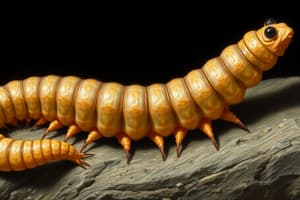Podcast
Questions and Answers
What is the primary characteristic of trematodes in their life cycle?
What is the primary characteristic of trematodes in their life cycle?
- They lack any intermediate hosts.
- Asexual reproduction occurs in snail hosts. (correct)
- They exclusively reproduce sexually.
- All stages occur within mammals.
Which of the following is a common method for diagnosing fascioliasis?
Which of the following is a common method for diagnosing fascioliasis?
- Blood sample analysis for antibodies.
- Recovery of adult fluke during surgery. (correct)
- Detection of adult form in urine.
- Visual inspection of liver tissue.
What type of fluke is Clonorchis sinensis, and how is it typically transmitted?
What type of fluke is Clonorchis sinensis, and how is it typically transmitted?
- Intestinal fluke; through direct skin contact.
- Liver fluke; by ingesting undercooked fish. (correct)
- Lung fluke; through inhalation of contaminated air.
- Liver fluke; through consumption of fresh vegetables.
Which trematode species is known to cause schistosomiasis?
Which trematode species is known to cause schistosomiasis?
What are the visible symptoms of trematode infections largely associated with?
What are the visible symptoms of trematode infections largely associated with?
How are the eggs of Paragonimus westermani primarily excreted?
How are the eggs of Paragonimus westermani primarily excreted?
What type of fluke is Fasciola hepatica commonly known as?
What type of fluke is Fasciola hepatica commonly known as?
What should patients follow to avoid misdiagnosis of fascioliasis?
What should patients follow to avoid misdiagnosis of fascioliasis?
Flashcards
Helminth
Helminth
A parasitic worm.
Trematodes
Trematodes
Parasitic flatworms (flukes) with a life cycle involving both sexual and asexual reproduction in different hosts.
Clonorchis sinensis
Clonorchis sinensis
Chinese liver fluke; transmitted via undercooked fish.
Fasciola hepatica
Fasciola hepatica
Signup and view all the flashcards
Paragonimus westermani
Paragonimus westermani
Signup and view all the flashcards
Schistosoma
Schistosoma
Signup and view all the flashcards
Schistosomiasis
Schistosomiasis
Signup and view all the flashcards
Diagnosis (Trematodes)
Diagnosis (Trematodes)
Signup and view all the flashcards
Study Notes
Helminths
- Helminth is a general term for parasitic worms.
- Trematodes are a type of flatworm (flukes).
- Trematodes have unique life cycles.
- They reproduce sexually in vertebrate hosts and asexually in intermediate snail hosts.
- In humans, trematodes can be liver flukes, intestinal flukes, or lung flukes.
- Blood flukes, such as Schistosoma, live in blood vessels and enter humans through penetration of the skin.
Trematode Species
- Clonorchis sinensis (Chinese or oriental liver fluke) - acquired from undercooked fish.
- Fasciola hepatica (sheep liver fluke) - found worldwide.
- Paragonimus westermani (oriental lung fluke) - acquired from eating undercooked crustaceans (e.g., crabs and crayfish).
- Schistosoma haematobium, japonicum, and mansoni: These are blood flukes, located in different regions (Africa and the Middle East and Far East for the different species).
Trematode Life Cycle
- Life cycles involve free-swimming larvae.
- Larvae can penetrate the skin of humans or be ingested.
- Eggs are passed through feces or urine.
Trematode Diagnosis
- Microscopic identification of eggs in stool or urine is common.
- Eggs may not be present immediately after infection.
- Sometimes, the adult fluke can be retrieved through surgery.
- Antibody detection tests are useful in early stages or ectopic fascioliasis.
Symptoms and Diseases
- Signs and symptoms are related to the location of adult worms in the body.
- Infection can cause granulomatous reactions and fibrosis in organs such as the liver.
- Cystitis and ureteritis (with hematuria, potentially leading to bladder cancer) with infection by S. haematobium.
Paragonimus westermani
- Known as the oriental lung fluke.
- Eggs are excreted unembryonated in sputum or stool.
- Transmission from undercooked freshwater crustaceans such as crabs and crayfish containing metacercariae.
- Most common in regions of the Far East.
Schistosomiasis
- Caused by Schistosoma blood flukes.*
- Eggs are eliminated with feces or urine.
- Different geographic areas connected to different species; S. mansoni (South America, Caribbean, Africa, Middle East); S. haematobium (Africa and Middle East); S. japonicum (Far East)
- Symptoms may appear depending on the site of infection.
- Diagnosis is done via microscopic examination of stool or urine.
Studying That Suits You
Use AI to generate personalized quizzes and flashcards to suit your learning preferences.




